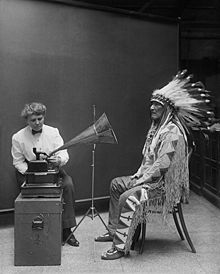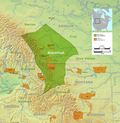The massacre

A command led by Major Eugene M. Baker left Fort Ellis on January 6, 1870, and stopped at Fort Shaw to pick up two more companies, including scouts Joe Kipp and Joseph Cobell who were familiar with the Piegan bands. These scouts were critical to distinguishing between the unfriendly and friendly Piegan bands, as Baker was to refrain from attacking the friendly bands. Baker needed to wait until Sheridan's division inspector general Colonel James A. Hardie reviewed the situation and reported back to him.
Based on Hardie's January 13 report, Sheridan issued an order to "strike them hard". [2] Baker's command, consisting of four companies of the 2nd U.S. Cavalry, and 55 mounted men of the 13th U.S. Infantry, moved North from Fort Shaw on January 19, looking for Mountain Chief's band, which was purportedly located in the Marias River country. [2]
Baker's command came across a small Piegan camp on January 22 and captured the occupants. These prisoners informed Baker that the Big Horn and Red Horn camps—two Piegan leaders considered hostile—could be found a few miles downstream. Baker ordered a forced march that night and moved his mixed infantry and cavalry forces through rough country, locating a camp of 32 lodges in the low ground along the Marias River just South of present-day Dunkirk, Montana. Baker positioned his men on the high ground above the camp in a "natural firing range" and prepared to attack. [2]
The camp
More than three hundred Piegan people were sleeping in Heavy Runner's camp in the predawn hours of January 23. Smallpox had struck, and many people were suffering from the disease. Most of the healthy men had left the camp to hunt. So, on that bitterly cold morning, nearly all the camp's occupants were women, children, or elderly. [14]
The shooting
Scout Joe Kipp recognized that the camp belonged to Heavy Runner, considered peaceful and not to be attacked per orders from Fort Shaw commander Colonel Philippe Régis de Trobriand. When told that the camp belonged to Heavy Runner, Baker responded, "That makes no difference, one band or another of them; they are all Piegans [Blackfeet] and we will attack them." Baker then ordered a sergeant to shoot Kipp if he tried to warn the sleeping camp of Blackfeet and gave the command to attack. [15] Kipp shouted to try to prevent the attack, and Baker placed him under arrest.
The noise alerted the Piegan camp and Chief Heavy Runner. Heavy Runner ran toward the soldiers, "shouting and waving a piece of paper—a safe conduct from the Indian Bureau." [2] He was immediately shot and killed. Scout Joseph Cobell later took credit for shooting Heavy Runner. Cobell was married to the sister of Mountain Chief and wanted to divert attention from his brother-in-law's camp, which he knew was about 10 miles (16 km) downstream. After Cobell's first shot, the rest of Baker's command opened fire. [2]
From the ridges above the camp, the soldiers shot into lodges filled with sleeping people. After a while, they charged into the camp. William Birth of Company K boasted that they sliced open lodge coverings with butcher knives and shot the unarmed people inside. He said: "We killed some with axes" and "gave them an awful massacreing. [sic]" [14]
Survivors' accounts

Spear Woman was six years old at the time of the massacre. She remembered waking up to the noise of barking dogs. She watched Heavy Runner run toward the troops, holding his "name paper" above his head. Then the soldiers began shooting. She ran into a nearby lodge and hid behind a bed backrest. While she waited, soldiers moved from lodge to lodge, killing her people. One soldier cut a hole in the lodge where she hid and shot everyone who moved. [14]
Buffalo Trail Woman saw soldiers surround a lodge and shoot into it in unison. They then took blankets, robes, and anything else they wanted. Finally, they tore down all the tipis and set everything on fire. She saw them burn wounded people in the conflagration. [14]
Long Time Calf escaped through the freezing waters of the Marias River, carrying her infant niece. She was eight years old. [14]
Bear Head had gone out of the camp to catch his horses when he encountered soldiers. They took him prisoner. He saw Heavy Runner run toward the soldiers, waving a paper, and then fall as the troops opened fire. He saw soldiers shoot at the tops of lodges, cutting the bindings and collapsing them onto the fire so that they smothered and burned their occupants. He watched them do this to the lodge of his mother, Fair Singing Woman, killing her and his father's three other wives and their four daughters. He saw them tear down all the remaining lodges, shoot the occupants, and burn everything, bodies, and lodges together. Powerless to save his family, Bear Head wished the soldiers had killed him, too. After the soldiers left, a few people returned to the camp from their hiding places in the brush. They buried the dead as best they could. Bear Head counted fifteen men, ninety women, and fifty children dead. [16]

